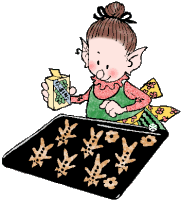|
Roast
Chicken, Savoury Bread Pudding & Tarragon
(serves
4)
Ingredients
1 organic free-range chicken (about 1.5kg/3lb50z)
1 lemon, halved
fresh thyme
softened, unsalted butter
1 glass white wine
1 tbsp fresh tarragon, chopped
For the bread pudding:
450ml/16fl oz milk
1 small bay leaf
1 sprig fresh thyme
1 garlic clove, peeled and crushed
2 whole cloves
grated zest ½ lemon
freshly grated nutmeg
unsalted butter
150g/5oz white bread, crust removed and broken up
1 small onion, peeled and very finely chopped
1 egg and 2 egg whites
salt and freshly ground black pepper
Method
1. To make the bread pudding: put the milk, bay leaf, thyme,
garlic, cloves, lemon zest and a little nutmeg in a saucepan and heat
until bubbles form around the edge of the pan. Remove from the heat and
set aside to infuse for 20 minutes.
2. Meanwhile prepare the moulds. Brush all over the inside of four chilled
dariole moulds with a thin layer of melted butter, then return to the
fridge or freezer to chill until the butter has set. Brush with another
layer of melted butter and chill again.
3. Put the bread in a bowl, strain over the flavoured milk and leave to
soak for 20 minutes.
4. Preheat the oven to 180C/350F/Gas4.
5. To prepare the chicken for roasting: set it in a small roasting tin or
dish. Squeeze the juice from one lemon half over the bird and put the
squeezed half inside the body cavity with some thyme. Truss the bird by
tying up the wingtips to the knuckle joints on the legs. Spread softened
butter all over the bird, then sprinkle with more thyme (leaves and/or
flowertips).
6. Put the chicken into the oven and roast for 1½-1¾ hours, basting with
the juices in the tin from time to time. To test if the chicken is cooked
pierce the meaty part of the thigh with the tip of a sharp knife, the
juices that run out should be clear.
7. Meanwhile, finish the bread pudding. Melt a small knob of butter in a
pan and sweat the onion until very soft but not coloured. Add to the
soaked bread. Lightly beat the egg with the egg whites and add to the
bowl. Mix together thoroughly and season. Spoon into the buttered dariole
moulds. Set the moulds on a layer of folded newspaper in a small roasting
tin and pour hot water into the tin to come half way up the sides of the
moulds.
8. Put into the oven with the chicken to bake for 1 hour.
9. When the chicken has finished cooking, put it on a carving board and
set aside in a warm place to rest for 15 minutes. Skim off some of the fat
from the juices in the tin. Set the tin over a moderate heat, add the wine
and bring to the boil. Check the seasoning, then add a squeeze of lemon
juice and the tarragon. Keep hot.
10. Carve the chicken and divide among the hot plates. Turn out the bread
puddings and put one on each plate. Moisten the chicken and puddings with
the sauce and serve.
Fish and Chips
A hint about the chips. Some people cook the chips then keep them warm
until the fish is ready. This is OK but the chips can very easily get
''soggy'' when kept warm. It is better keep the fish warm and serve the
chips as soon as they are cooked. 'Fresh' chips taste so much better.
Two final
suggestions: the secret is in the batter. For an unusual taste consider
adding about 2 tablespoons of a dark beer (not lager) to the batter
mixture - or add 2 teaspoons of Worcestershire sauce. Please, do not add
garlic, chilli powder nor paprika powder, that will not give 'English'
fish and chips!
This will serve 4
(depending on how many portions of fish you use).
Ingredients:
4 large pieces of cod
(or haddock)
1kg or 2½ lbs
potatoes
Sunflower seed oil
Salt and fine white
pepper to taste.
For
the batter:
200g or 7 oz of plain
flour
1 large egg
150ml or 5 fl oz of
water and milk mixed (making 5fl oz total)
White pepper to taste
1. Peel the potatoes
and cut them into chips. If you are not going to cook them immediately
then keep them covered in water to stop them going brown.
2. Start to make the
batter mixture by putting the flour into a large bowl.
3. Whisk the egg and
add (if you want) a maximum of 2 tablespoons of dark beer or 2 teaspoons
of Worcestershire sauce.
4. Now pour the
whisked egg into the flour adding the milk/water mixture and beat until
smooth. Leave this to stand for an hour.
5. Heat a deep pan,
filled with enough oil to cover the chips, until it is hot. (If you drop
in a tiny piece of potato and it immediately starts to fizzle then the oil
is hot enough).
6. Heat a second pan
of oil just deep enough to cover the fish.
7. Individually put
each fish fillet into the batter. Slide the fish back and forth to cover
with batter and lift out and allow to drip for a second or two then
repeat. This makes sure the fish is completely covered in batter.
8. Lower a battered
fish into the hot oil skin side to the bottom of the pan to stop the
fillet curling as it heats. Now cook, one fillet at a time. After 5
minutes turn the fish over and cook for another 3 to 4 minutes.
9. Repeat with the
second fillet, keeping the first cooked fillet warm in an oven.
10. Now put the chips
in the pan to cook. Take care as the oil might froth as the wet chips go
in. This is quite normal but be careful you do not burn yourself.
11. Carry on cooking
the other two fillets and put them in the oven to keep warm.
12. Lift out the chips
when they reach a nice golden brown colour and are cooked. Use a mesh
spoon or similar to lift the chips out, letting the oil drip back into the
pan.
Serve on plates (or
newspapers) with the fish nestling on a bed of chips. Vinegar, salt and
tomato sauce (ketchup) should be available.
Steak and Guinness
Serves 4
1 pound eye round steak, cubed
1 tablespoon all-purpose flour
salt and pepper to taste
1 teaspoon brown sugar
1 tablespoon raisins (optional)
5 medium onions, peeled and chopped
1 1/2 cups (300 ml) Guinness Stout
8 slices bacon, chopped
3 ounces lard fresh parsley, chopped
double crust pie pastry
1. Cut the steak into bite-size cubes and roll in the
salt and pepper seasoned flour. Brown the steak cubes in the lard with
the bacon over medium heat in a heavy skillet for 8 to 10 minutes until
golden brown. Please the meat in a casserole dish to cool. In the
remaining bacon and lard drippings sauté the onions until golden and
add to the meat when browned.
2. In a mixing bowl combine raisins and brown sugar with
the Guinness. Let stand for 5 minutes for raisins to plump.
3. Add the mixture to the casserole dish, cover tightly
and simmer over low heat on in a very moderate oven at 325 degrees F for
2 1/2 hours. Stir occasionally and add a little more Guinness or water
if the rich brown gravy gets too thick.
4. Meanwhile, line a deep pie dish with half the prepared
pie crust and pre-bake as directed. Add the Guinness and beef mixture
from the casserole to the baked pie crust. Cover the meat mixture with
the remaining pie crust layer and bake until finished, approximately 10
minutes. Remove pie from the over to cool, slice and serve with
potatoes.
5. Variations: Substitute 3 tablespoons honey for the
brown sugar. Either ingredient takes the bitter bite out of the
Guinness. If you do not care to cook with lard, substitute vegetable oil
for browning the meats.
Minted Lamb Pie
(serves 6)
Ingredients
750g – 1kg lamb or hogget
2 Tbsp oil
1 carrot, peeled and diced
2 medium-sized parsnips, peeled and diced
1 leek, trimmed, washed and finely diced
1 tsp minced garlic
2 tsp flour
1 cup beef stock
1 cup medium sweet sherry or use beef stock
½ cup raisins
2 Tbsp barley or brown rice
¼ cup chopped fresh mint
400g packet flaky puff pastry, defrosted
1 egg, beaten (to glaze with)
Cut the lamb into 2-3cm sized pieces. Season well with salt and pepper
and brown quickly in hot oil. Set aside.
Add the vegetables to the pan and stir over a moderately high heat until
the vegetables begin to brown a little (you may need to add a touch more
oil). Stir in the garlic and flour and cook for 1 minute. Do not
overcook, as the garlic will burn.
Stir in the sherry or stock, raisins and barley or brown rice and bring
to a simmer. Transfer with the lamb to a casserole and cover.
Cook at 160°C until the lamb is tender. Cool, then stir in the mint and
season with salt and pepper. Before covering with pastry, cool
thoroughly. (If the pastry is placed on a hot filling it will have a
soggy layer underneath.)
Transfer the cold mixture to a large pie dish, preferably one with a
lip. Place a pie funnel in the center if you have one, or make one from
foil. Brush the rim with water or egg glaze.
Roll out the pastry to 2cm larger than the pie dish. Cut a 1cm-wide
strip and press this onto the pie dish rim. Then carefully roll the
larger piece of pastry over the pie, pressing the top firmly onto the
pastry-covered pie rim. Do not pinch the edges together though. Trim the
edges.
Brush with egg glaze, being careful to avoid any glaze going over the
cut edge of the puff pastry, as it will glue the layers together and
prevent them from rising.
Bake at 220°C for 10 minutes and then lower the temperature to 200°C
for a further 20 minutes until the puff pastry is well risen and golden
and the filling is hot.
|
|



